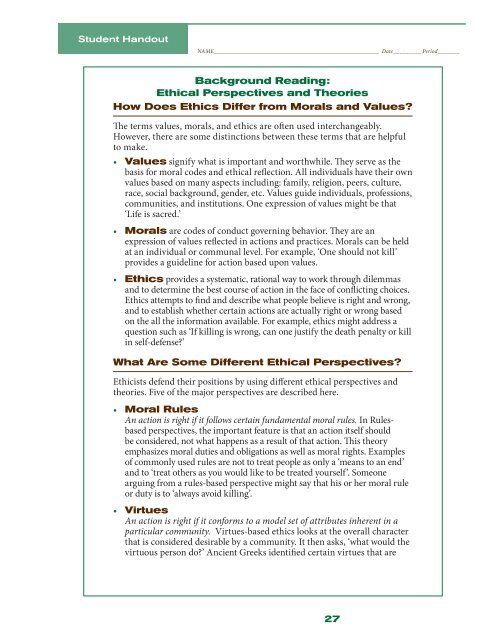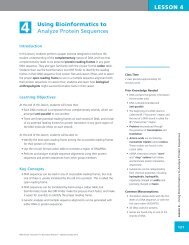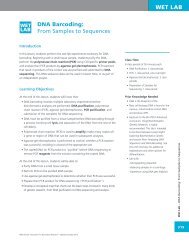27 Background Reading: Ethical Perspectives and Theories How ...
27 Background Reading: Ethical Perspectives and Theories How ...
27 Background Reading: Ethical Perspectives and Theories How ...
You also want an ePaper? Increase the reach of your titles
YUMPU automatically turns print PDFs into web optimized ePapers that Google loves.
Student H<strong>and</strong>outNAME___________________________________________________________ Date_________ Period_______<strong>Background</strong> <strong>Reading</strong>:<strong>Ethical</strong> <strong>Perspectives</strong> <strong>and</strong> <strong>Theories</strong><strong>How</strong> Does Ethics Differ from Morals <strong>and</strong> Values?The terms values, morals, <strong>and</strong> ethics are often used interchangeably.<strong>How</strong>ever, there are some distinctions between these terms that are helpfulto make.• Values signify what is important <strong>and</strong> worthwhile. They serve as thebasis for moral codes <strong>and</strong> ethical reflection. All individuals have their ownvalues based on many aspects including: family, religion, peers, culture,race, social background, gender, etc. Values guide individuals, professions,communities, <strong>and</strong> institutions. One expression of values might be that‘Life is sacred.’• Morals are codes of conduct governing behavior. They are anexpression of values reflected in actions <strong>and</strong> practices. Morals can be heldat an individual or communal level. For example, ‘One should not kill’provides a guideline for action based upon values.• Ethics provides a systematic, rational way to work through dilemmas<strong>and</strong> to determine the best course of action in the face of conflicting choices.Ethics attempts to find <strong>and</strong> describe what people believe is right <strong>and</strong> wrong,<strong>and</strong> to establish whether certain actions are actually right or wrong basedon the all the information available. For example, ethics might address aquestion such as ‘If killing is wrong, can one justify the death penalty or killin self-defense?’What Are Some Different <strong>Ethical</strong> <strong>Perspectives</strong>?Ethicists defend their positions by using different ethical perspectives <strong>and</strong>theories. Five of the major perspectives are described here.• Moral RulesAn action is right if it follows certain fundamental moral rules. In Rulesbasedperspectives, the important feature is that an action itself shouldbe considered, not what happens as a result of that action. This theoryemphasizes moral duties <strong>and</strong> obligations as well as moral rights. Examplesof commonly used rules are not to treat people as only a ‘means to an end’<strong>and</strong> to ‘treat others as you would like to be treated yourself’. Someonearguing from a rules-based perspective might say that his or her moral ruleor duty is to ‘always avoid killing’.• VirtuesAn action is right if it conforms to a model set of attributes inherent in aparticular community. Virtues-based ethics looks at the overall characterthat is considered desirable by a community. It then asks, ‘what would thevirtuous person do?’ Ancient Greeks identified certain virtues that are<strong>27</strong>
still widely recognized today as important such as compassion, honesty, courage,<strong>and</strong> forgiveness. Virtue ethics looks at the whole person <strong>and</strong> their behaviors overtheir lifetime in many situations. For example, killing may not be considered inharmony with a virtuous character that emphasizes forgiveness.• OutcomesAn action is right if good consequences outweigh bad consequences. Outcomebasedapproaches look at the results of actions in determining whether theyare ethical or not. Often this theory will look for solutions that will create thegreatest ‘good’ for the greatest number. For example, killing some people maybe justified under this perspective if many more will be saved as a result.• PrinciplesAn action is right if it follows the principles:Respect: Respect individuals <strong>and</strong> their autonomy (right to makeindependent choices).Beneficence: Be of benefitNon-maleficence: Minimize harmJustice: Treat others equitably, distribute benefits/burdens fairlyThe principles provide a combination of rules <strong>and</strong> outcomes-basedperspectives. For example, respect for individuals <strong>and</strong> justice are focused moreon rules, <strong>and</strong> beneficence <strong>and</strong> non-maleficence require looking at the outcomeof an action. The principles are widely used in biomedical ethics. Suppose aperson who was dying wished to be killed. The principle of autonomy might beinterpreted to say that in order to respect that individual’s wish, they shouldbe killed. <strong>How</strong>ever, suppose the patient had asked a doctor to do the killing. Adoctor who had vowed not to harm others might invoke the principle of nonmaleficence<strong>and</strong> decide they could not kill the patient.• CareAn action is right if it acknowledges the importance <strong>and</strong> value ofinterpersonal relationships. Care ethics also looks at the underlying powerstructures of a situation. For example, an ethicist using the perspective ofcare might look at how an oppressive or exploitative social structure mayunderlie an act of killing.Each of these perspectives allows different questions to be asked of an ethicaldilemma. For example, in looking at different solutions one might ask, “Whichone provides the greatest good for the greatest number?” “Which solutions arethe most fair to the parties involved?”, or “Which are consistent with moralrights <strong>and</strong> duties?” Familiarity with these perspectives can provide you witha language to describe <strong>and</strong> defend your position, <strong>and</strong> help you see how yourarguments align with established philosophical perspectives.28
















